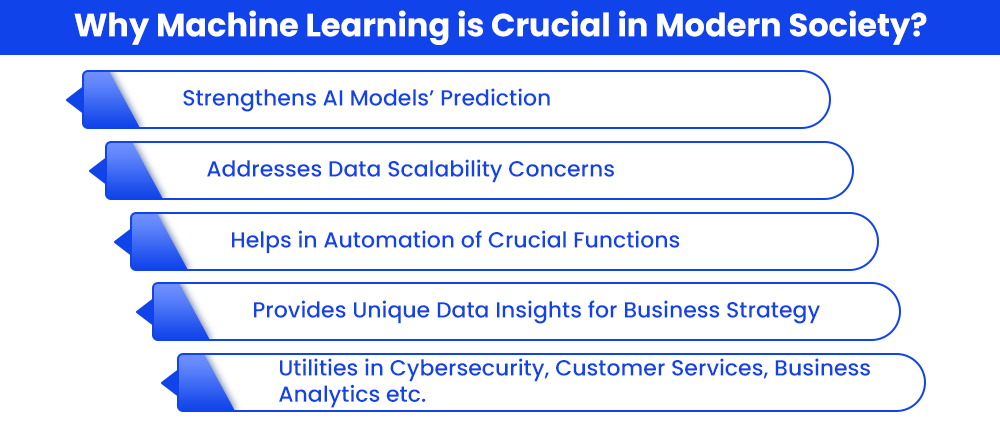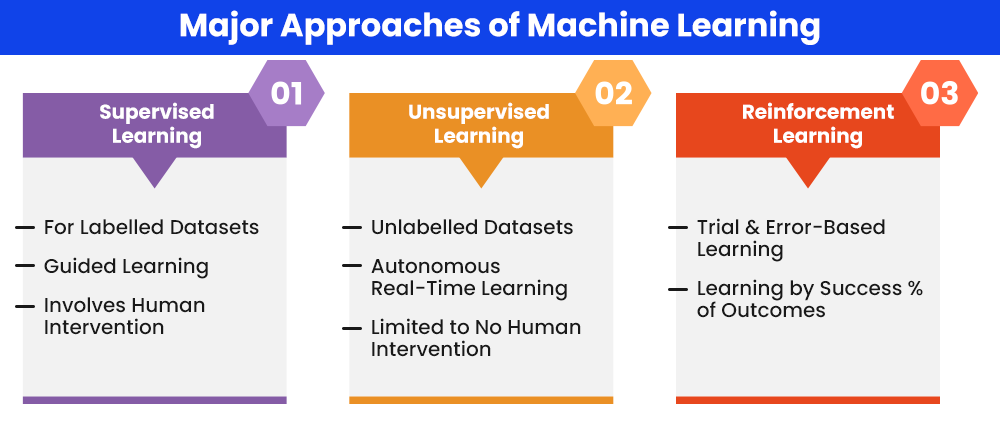Expert Interviews
- University Reviews
- Career Guide
 Video Counseling
Video CounselingImportant Facts
- Ask any Question - CV Forum

What Is Machine Learning (ML)? How Does It Work?
College Vidya Team Jan 15, 2025 1.3K Reads

An up-and-coming domain of artificial intelligence (AI), machine learning refers to the autonomous or supervised learning by machines that occurs through the use of algorithms and data models. Machine learning, commonly abbreviated as ML, serves a central role in enhancing the accuracy of AI models and software in the prediction and effective simulation of human intelligence.
In this blog, we have delved into the depths of machine learning, its foundations, and basic functioning principles. Continue reading to explore the nuances of the field as well as the scope it holds for the future!
What is Machine Learning (ML)?
Machine learning, at its heart, involves the meaningful analysis of data to derive insights that can be utilized in further operations of the software for accurate prediction and results. As the name indicates, machine learning involves the learning and training of machines (or software integrated with AI principles) by feeding large datasets to derive insights. It involves data mining to make predictions and classifications guiding the operations of the model in the future.
Machine learning is a field that interacts with the domains of AI and data science, allowing for the model to apply statistical models and analyses to interpret vast datasets to guide findings and insights that can be integrated into the model’s functioning to enhance accuracy. Machine learning models develop accuracy in prediction over time, as they are trained with more data inputs from users in real-time, which are further utilized by the model to drive decision-making and problem-solving in the future. Also Read | What Is Artificial Intelligence (AI)? How Does It Work?
There are numerous examples of machine learning being utilized in AI-powered applications and programs, with the most prominent use being the personalized suggestions that are provided by applications such as video-streaming applications, music applications, social media applications, etc. The integration of machine learning into AI software has enhanced their power for accurate predictions.
Importance of Machine Learning
The importance of machine learning is well-recognized not only in the fields of AI and computer science but also in data science and analytics. Firstly, with the advent of emphasis placed on data insights, effective ML models can draw useful conclusions and insights from vast datasets to provide results to business enterprises to guide their functioning and strategy formulations.
With the further sophistication of machine learning models over the years, their impact has expanded beyond the mere utilization for business strategy formulation. Today, big data analytics and ML technologies are actively deployed in various applications and social media platforms to get user insights, customer trends, and preferences and actively utilize them to tap into a larger audience, provide personalized user suggestions, contacts, etc. Furthermore, there are essential applications of ML technologies in domains like self-driving cars, cyber fraud detection, customer services, cybersecurity, business analytics, etc.

The applications of machine learning are thus all-pervading. The applications of machine learning have implications for mitigating cyber frauds and risks, reducing costs growing business for organizations, and so on. The scalability of data which puts constraints on their processing and resources available to do the same, can be easily tackled by ML models. Further, since the models of machine learning autonomously and continuously learn as they operate with new data, they are much more likely to be able to infer unique and often unexpected findings from data that can guide their operations successfully. Their role is becoming increasingly central to the operations of businesses and enterprises driven by technology.
Difference between Artificial Intelligence, Machine Learning & Deep Learning
To explore machine learning as a domain, it is useful to distinguish it from two of its most closely related fields, namely artificial intelligence and deep learning.
While artificial intelligence is the broad domain of computer science that seeks the development of holistic programs and software that can operate and deliver solutions smartly by simulating human intelligence, machine learning is a subdomain of AI that focuses on the training of such software to enhance their accuracy and further increase the chances of producing successful outcomes with time.
On the other hand, while machine learning is a field of AI, deep learning is a subfield of machine learning. Machine learning emphasizes the overall learning and training of AI models through a variety of algorithms and statistical techniques, while deep learning is one of the subfields within ML that is specifically focused on learning via networks that resemble the human neural network. Thus, deep learning is focused upon the networks created in models similar to neural networks, and further on their effective functioning.
Thus, while machine learning and artificial intelligence, and in some cases, deep learning and machine learning are used as synonymous terms, they have important distinctions in their basic purpose, main functions as well as operations. To learn more about the differences between AI and ML, read [insert link for AI vs ML blog] and to know further about the differences between AI, ML, and deep learning, click here [insert link for AI vs ML vs DL blog].
Types of Machine Learning: Common Methods in ML
To grasp the functioning of machine learning models, it is important to know the types of ML, which have been conceptualized in various ways, be it the type of machine learning or the method of operation of ML. There are three major clusters or types of ML methods–supervised, unsupervised, and reinforcement learning, which have been elaborated upon further herein.

1 ) Supervised Learning
When known datasets or labeled data are used for training the machine learning model, the learning that entails is known as supervised learning. It is called so since the programmers have control over the data being fed into the model and hence can guide the learning towards a successful execution. The use of known data facilitates the model to draw relevant insights and utilize them further when processing new data and making predictions. Supervised learning commonly includes the use of various algorithms such as regression (linear and logistic), random forest algorithm, polynomial regression, decision trees, naive Bayes, etc.
2 ) Unsupervised Learning
Unsupervised learning is a method of machine learning in which there is no involvement of labeled data. Rather, unknown or unlabelled data is utilized for analysis, spotting of patterns in the same, and further drawing relevant insights to guide decision-making and prediction by the model. Since the data fed into an ML model in unsupervised learning is not controlled or known to the model creators, human intervention is minimal in this type of learning, and hence, the learning may not necessarily get directed toward the outcome desired by the creators. Rather, the machine actively learns on its own to identify recurrent patterns and become increasingly accurate over time. Some of the commonly used algorithms for unsupervised learning in ML include partial least squares methods, fuzzy means methods, apriori statistical techniques, principal component analysis, K-means clustering, and so on.
3 ) Reinforcement Learning
As the name suggests, reinforcement learning is a contingent form of learning emulating the traditional trial and error approach to finding solutions to problems ML model over time learns to identify responses that lead to successful outcomes or accurate results and learns to exhibit the same response in similar conditions as a result. The inaccurate responses slowly extinct as the model learns to associate actions with outcomes. Reinforcement learning involves three components–the agent (i.e. the ML model taking actions), the environment (all forms of input that the model interacts with), and the actions (the operations, decisions, and solutions deployed by the model). A well-articulated and sound policy framework is conducive to enhancing the chances of success of the model to provide solutions yielding rewards in the long run. Commonly used approaches in reinforcement learning include those like policy optimization, policy-iteration methods, policy gradient, Q-learning, etc.
Thus, it can be seen that the functioning of machine learning is underlined by the above-mentioned three models of ML namely supervised learning, unsupervised learning, and reinforcement learning (RL). Furthermore, we have dived into the working of machine learning models concerning its common stages, its prominent algorithms, and the best courses to learn more about machine learning.
How Machine Learning Works: Stages of Machine Learning
As described earlier, the method of ML being deployed in a model (vis. a vis. supervised, unsupervised, or reinforcement learning) can impact the exact stages that underlie its functioning. However, here we have delineated the working of machine learning into 3 of its major stages or components (as described by the UC Berkeley School of Information).

- Decision Process: The very first component of machine learning is the decision process, wherein the model actively processes data (labeled or unlabelled) and further tries to predict and find relevant patterns in it. This includes a number of complex calculations and analyses using algorithms.
- Error Function: The purpose of this stage is mainly evaluative–the error function of an ML model entails the evaluation of the predictive accuracy of the model. This process usually occurs with the help of known examples as and when they are available, to evaluate how accurate (or conversely how inaccurate) the model is concerning the solutions and predictions it devises.
- Model Optimisation Process: The process of model optimization concerns the evaluation of the misses committed by the model (by comparison with known examples through the error function) and a further optimization process to ensure the model becomes more accurate in further operations. This process is usually continuous and autonomous, meaning that the model continuously assigns and reassigns weights to various data points to drive the model toward greater accuracy.
The process of working on machine learning can be understood by the brief example mentioned here. If we consider, for instance, an ML model aiming to provide personalized music recommendations to users on a music application, then the first stage of the decision process would occur when the model is fed with labeled data about user engagement with the platform and their past music choices.
This would entail the algorithm crawling this data to derive insights about user preferences based on a number of possible parameters–music choices based on artists, movies, music directors, genres, and so on. The algorithm identifies these parameters, assigning weights to them. Based on this analysis, the application can suggest personalized playlists designed for the user based on various parameters.
The error function would occur by assessing the accuracy of the model (for instance by assessing the hits on playlists prepared by the algorithm) and accordingly match it with previously available data (if any) to assess the degree of accuracy. Lastly, the model optimization would occur in turn by continuously assigning and reassigning weights to the various data points to drive increasingly toward success.
Common Algorithms in Machine Learning
Several statistical techniques and algorithms are deployed in machine learning models and hold useful potentials for application depending upon several factors including those:
- Size of the dataset being fed into the model
- Type of data being fed into the model
- Types of data insights expected from the algorithm
- The purpose of training the model, including the use of the data insights

Based on the specific needs and characteristics of the dataset provided for training, a number of algorithms can be used in ML models, which have been described herein.
- Linear Regression: This algorithm makes use of the statistical technique of linear regression which predicts numerical values based on linear relationships between data, i.e. a relationship between a predictor variable (for e.g. demand) on an outcome variable (for e.g. prices of a product). This is a type of supervised learning algorithm in machine learning.
- Logistic Regression: Unlike linear regression which identifies a linear relationship between two variables on a continuum of data points, logistic regression techniques are associated with the prediction of outcomes for binary variables, i.e. variables that are categorical with dichotomous responses (e.g. yes/no, true/false etc.). As can be seen, this type of algorithm is more suitable for categorical data than numerical data. Logistic regression is a type of supervised learning in machine learning.
- Neural Networks: The neural network is another advanced algorithm that can be utilized in several ML functions including natural language processing, image creation, processing and identification of images, patterns, etc. At the crux of neural processing algorithms are numerous processing nodes and data points which are interconnected in a web-like manner to simulate the human neural pattern and its functioning.
- Clustering: As the name suggests, clustering algorithms in machine learning are used for the identification of patterns in a dataset to group data based on their similarities. Some of the common clustering algorithms used in machine learning include those like K-means, DB-Spatial Clustering of Applications with Noise (DBSCAN), mean shift, Gaussian Mixture Models, Self-Organizing Maps, Hierarchical Clustering, etc. Clustering is a type of unsupervised learning in ML.
- Decision Trees: Decision tree algorithms make use of branching sequences of linked decisions that can be represented with a tree diagram. This algorithm works well with both numerical as well as categorical data and provides a major advantage of the ease of validation and audit. It is a supervised learning technique of machine learning.
- Random Forests: When multiple decision trees are used to create an algorithm, it results in a random forest that makes use of information from these multiple decision trees to finally arrive at a numerical or categorical prediction.
Thus, numerous ML algorithms can be utilized by an ML engineer to train AI models efficiently and arrive at the most effective predictions by the model based on a number of factors.
Upskilling in Machine Learning: Top Courses to Pursue in 2025
Upon the in-depth discussion about the process of machine learning and its fundamental components and aspects, we have enlisted a few of the popularly chosen courses in Machine Learning that one can consider taking up for their journey of higher education and upskilling.
Desirable courses that one can set one’s eyes on for gaining skills in ML (and related domains) include certification courses (at the undergraduate, postgraduate as well as professional levels), diplomas (most commonly, PG diplomas) as well as full-time degrees courses.
A table of the most commonly sought courses in the field of machine learning offering an appealing career scope has been provided below. These courses are available to be conveniently pursued in both the offline as well as online learning modes.
Some of the courses may also be offered by institutions in the online mode.
| Courses may also be offered by institutions in the online mode | |
|
Online Diploma in Artificial Intelligence & Machine Learning (AI & ML) |
|
|
Online PG Program In Data Science |
|
|
Executive Program In Artificial Intelligence & Machine Learning |
|
Conclusion
Thus, as can be seen, the domain of machine learning is a crucial subfield in artificial intelligence systems for their enhanced accuracy. Machine learning includes the utilization of several algorithms and statistical techniques to draw insights from big data, guiding problem-solving and decision-making. The importance of ML technologies in the domain of computer science is invaluable owing to their pervasive applications and implications for enhanced accuracy of software, saving of resources including time and financial assets by enterprises, and analytical benefits.
Trending Articles
FAQs (Frequently Asked Questions)
Machine learning refers to a subfield of the domain of artificial intelligence that is concerned with the systematic analysis of vast data to draw insight from them based on certain algorithms and/or statistical models. The purpose of machine learning is to train AI models to perform more accurately by providing data insights to guide operations.
Although often used synonymously, AI and ML are not the same and connote different domains and technological fields. AI is a field of computer science that involves the development of programs and software able to operate similarly to humans with respect to their intelligence. On the other hand, machine learning is a field within the larger domain of AI, that is concerned with the training and autonomous learning of machines and computer software to make more accurate predictions.
Machine learning is a process of training machine models and AI programs to provide more accurate results based on the analysis of big data. It is a process in the field of artificial intelligence.
The steps involved in the process of machine learning include the decision process (feeding of labeled or unlabelled data into the model followed by due identification of patterns in the data by the model) followed by the error function (analysis of the accuracy of predictions made by the model by comparison with available data points and examples) and lastly by model optimization (the due correction of errors and optimization of the model to become more accurate through the reassignment of weight to data points).
The types of machine learning commonly identified in computer science include supervised learning, unsupervised learning, and reinforcement learning. Semisupervised learning has been identified as another major arena of machine learning in recent times.
The algorithm to use for machine learning would depend on many factors including those like the size of the dataset, the type of data (numerical versus textual, categorical versus non-categorical data, etc.), data insights needed from the dataset, ways in which the data insights are to be used, etc. Some of the common algorithms that are useful for beginners to try their hands on include linear regression, logistic regression, decision-tree, K-means, random forests algorithm, etc.

Idea Alchemist / Concept Creator / Insight Generator
We are an online education platform where users can compare 100+ online universities on 30+ X-factors in just 2 minutes. With an active CV community, we have transformed online learning to quite an extent. With the CV Subsidy scheme, we contributing to GER in India while helping our learners with their finances in their “Chuno Apna Sahi” journey!
Every query is essential.
Our team of experts, or experienced individuals, will answer it within 24 hours.
Recommended for you
Tired of dealing with call centers!
Get a professional advisor for Career!
LIFETIME FREE
Rs.1499(Exclusive offer for today)

Pooja
MBA 7 yrs exp

Sarthak
M.Com 4 yrs exp

Kapil Gupta
MCA 5 yrs exp
or



Career Finder
(Career Suitability Test)
Explore and Find out your Most Suitable Career Path. Get Started with our Career Finder Tool Now!
ROI Calculator
Find out the expected salary, costs, and ROI of your chosen online university with our free calculator.
